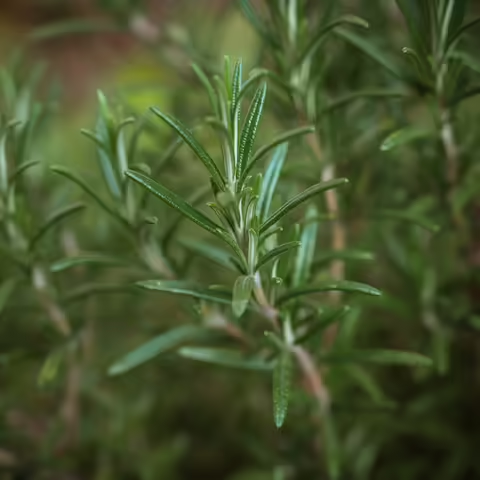Rosemary
Rosemarinus officinalis
Rosemary is a perennial evergreen shrub in warmer growing zones (zone 8 and above). Plants can grow to 4-6 feet tall with some varieties having a trailing or cascading habit. Foliage is dark green and needle-like much like a spruce or fir. A white band on the underside gives it a gray coloration. In the Midwest, rosemary often does not overwinter successfully and is best treated as a tender perennial, bringing it indoors for the winter. During the summer, rosemary produces small white, pink or blue flowers. The fragrance is an intense camphor or piney scent.
Growing: Tender Perennial
While rosemary can be grown from seed, it is best propagated from stem cuttings. Cuttings root easily and grow into suitable plants quickly. Seed germinates very slowly and the resulting plants may take years to become useable plants.
In the garden, rosemary prefers a full sun location with a soil that is well amended with compost and well-drained. Regular fertilization results in the best foliage for harvest. Because rosemary is not reliably hardy in zone 6 or colder, they are best overwintered indoors. If the plants are to be brought indoors it is suggested that they be planted in containers for outdoor use and not planted in the ground.
Rosemary plants grown in the garden do not transplant very well. So, to minimize chances of losing plants being dug up and moved indoors, it is suggested that they be treated as container plans on the deck, patio or porch. Plants can be left in the garden into the fall and brought in just before a frost occurs.
Once indoors, rosemary prefers a cool (even cold) sunny location where the humidity is high. Rosemary dries out quickly in an indoor growing environment usually leading to brown leaf tips and die-back. This does not mean water the plant more because this can lead to root rots and loss of the plant. Keeping the plants cool and placing them on pebble filled saucers filled with water helps to increase humidity around the plant and reduce foliage damage. Frequent misting is also helpful. Keep the soil on the dry side. Rosemary also does not do a lot of growing during the low light, cool days of winter. Rosemary is also a bold accent or specimen plant in containers. The prostrate forms are attractive in hanging baskets and as ground covers where they are hardy.
Popular Varieties
- ‘Arp’ - Grey-green foliage. One of the more cold-tolerant varieties to perhaps zone 6.
- ‘Gorizia’ – Tall upright form, large leaves, light blue flowers.
- ‘Blue Rain’ – Trailing variety, light blue flowers.
- Pine Rosemary – While not a culinary variety, it is excellent as an ornamental. Strong pine scent, fine leaves.
- ‘Tuscan Blue’ – Upright form, mild flavor.
- ‘Huntington Carpet’ – Trailing form, deep blue foliage.
Harvesting
The tender tips and foliage can be cut as needed throughout the growing season. Occasionally, longer, woody stems can be harvested and used as skewers for kabobs. Leaves may also be dried and stored for later use. Pruning the plants will encourage a tight compact habit. Plants can also be sheared or pruned into forms resembling small evergreens.
Use
Use rosemary sparingly as an accent to food as the flavor can be somewhat pungent and resinous. Use with fish, pork, lamb, poultry and game.
